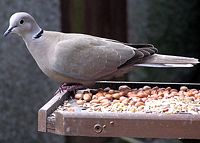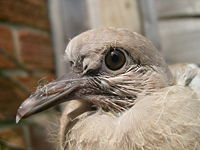Eurasian Collared Dove
2008/9 Schools Wikipedia Selection. Related subjects: Birds
| Eurasian Collared Dove | ||||||||||||||
|---|---|---|---|---|---|---|---|---|---|---|---|---|---|---|
 |
||||||||||||||
| Conservation status | ||||||||||||||
|
Least Concern
|
||||||||||||||
| Scientific classification | ||||||||||||||
|
||||||||||||||
| Binomial name | ||||||||||||||
| Streptopelia decaocto ( Frivaldszky, 1838) |
The Eurasian Collared Dove, Streptopelia decaocto, also called the Eurasian Collared-Dove or simply the Collared Dove, is one of the great colonisers of the avian world. Its original range was warmer temperate regions from southeastern Europe to Japan. However, in the twentieth century it expanded across the rest of Europe, reaching as far west as Great Britain by 1953; breeding in Britain for the first time in 1956, and Ireland soon after. It also now breeds north of the Arctic Circle in Scandinavia. It is not migratory.
It was introduced into the Bahamas in the 1970s and spread to Florida by 1982. Its stronghold in North America is still the Gulf Coast, but it is now found as far south as Veracruz, as far west as California, and as far north as British Columbia and the Great Lakes. Its impact on native species is as yet unknown; it appears to occupy an ecological niche between that of the Mourning Dove and Rock Pigeon; some have suggested that its spread represents exploitation of a niche made available by the extinction of the Passenger Pigeon.
It breeds wherever there are trees for nesting, laying two white eggs in a stick nest. Incubation lasts 14-18 days, and young fledge after 15-19 days. It is not wary and is often found around human habitation.
This is a small dove, buff grey with a darker back and a blue-grey wing patch. The tail feathers are tipped white. It has a black half-collar on its nape from which it gets its name. The short legs are red and the bill is black. The iris is reddish brown, but from a distance the eyes appear to be black, as the pupil is relatively large and only a narrow rim of reddish-brown eye colour can be seen around the black pupil.
This is a gregarious species, and sizeable winter flocks will form where there are food supplies such as grain. The song is a coocoo, coo repeated many times. It is phonetically similar to the Greek decaocto ('eighteen'), to which the bird owes its name. Occasionally it also makes a harsh loud mechanical-sounding call lasting about 2 seconds, particularly when landing in the summer.
The Eurasian Collared Dove is one of two species (the other, and the more likely, being the African Collared Dove, Streptopelia roseogrisea) that have been argued to be the wild ancestor of the domestic Barbary Dove, S. risoria. It is able to interbreed with the Barbary Dove.

